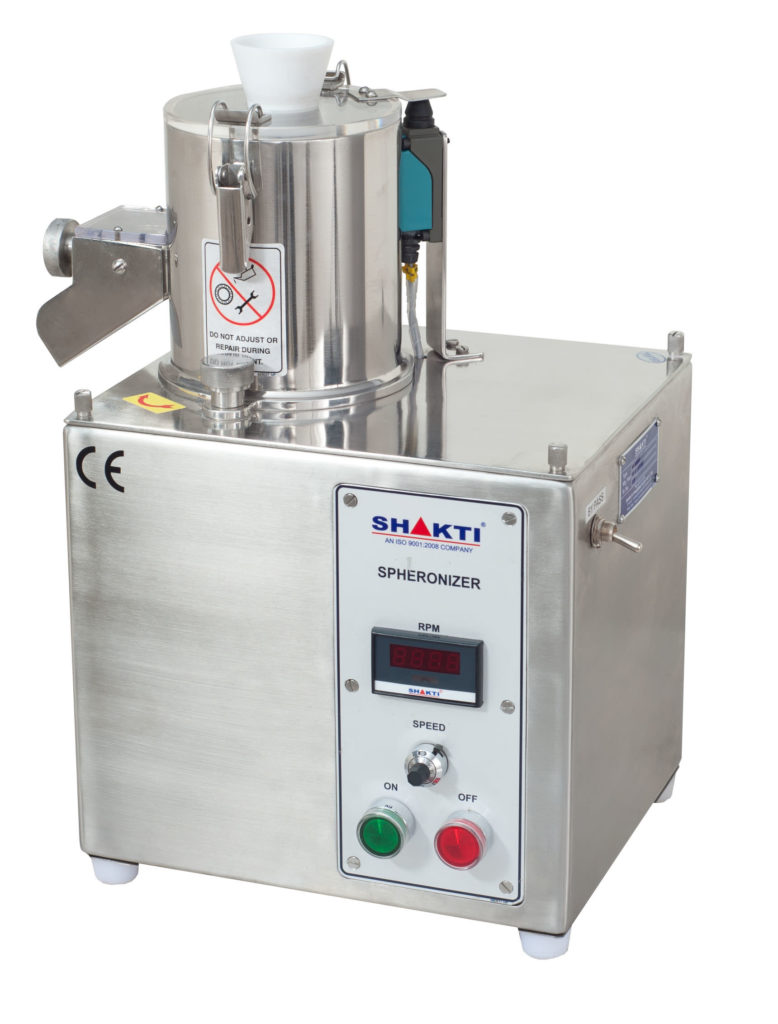 +91 98253 18370
Products
+91 98253 18370
Products
A Laboratory Table-top Spheronizer
This Equipment used for R & D or Teaching work with small quantities rare and expensive development compounds. Spheronization is widely used within the pharmaceutical and allied industries.
Spheroids are small spherical beads or pellets. That is generated in a Spheronizer from extruded material. The diameter of the spheroids is largely determined by the diameter of the Extrudate. You can use spheroids when incompatible active ingredients need to be presented in a single dose or when you require an active ingredient to have different release rates within a single formulation.
With spheroids you can have excellent flow and metering properties as well as packing uniformity. With spheronization you can reduce or eliminate dust hazards. Typical spheroid sizes are from 0.8mm to 3.0mm. The Spheronizer has an easy to use operating structure. The front panel has ‘Start’ button, ‘Stop’ and ‘Emergency stop’ button along with indicators for ‘Power on’, ‘Motor on’ and a speed control device that allows changes in disc speed during the spheronization process if required.
| TYPES | DETAILS |
|---|---|
| Loading Capacity | Manual Loading Of Wet Extrude Min 10g to Max 100 Gram |
| Output / Hr. | 130g / hr |
| Disc Fitted With Equipment | Cross Hatch Pattern 3 MM sq. |
| Disc Available [Optional] | Cross Hatch Pattern 2, 4 & 6 MM sq. |
| Typical Spheroid Size | Controlled By The Extrusion Process & Equipment. Typical Range 0.8 to 3.0 MM. |
| Cabinet Material | SS 304 Construction |
| Contact Parts Material | SS 316 Construction |
| Disc Speed | 10 to 1365 RPM. |
| Motor Power | 0.09 kw |
| Electric Supply | 110v / 60 Hz or 220v / 50 Hz Single Phase |
| Dimensions | 323 x 440 x 510 H |
| Weight | 26.5 kg. |
| Gross Weight | 50 kg. |
The ongoing action of particles colliding with the wall and being thrown back to the inside of the plate creates a “rope-like” movement of product along the bowl wall. The continuous collision of the particles with the wall and with the friction plate gradually turns the cylindrical segments into spheres, provided that the granules are plastic enough to allow the deformation without being destroyed.
It is essential that this rope movement is present for an optimal spheronization. When the particles have obtained the desired spherical shape, the discharge valve of the chamber is opened and the granules are discharged by the centrifugal force.
*Maximum batch size is volume limited and depends upon bulk density of the material being spheronized. For pharmaceutical materials normally about 500g of material is spheronized as a single batch.
Note: Batch size is volume limited and depends upon bulk density of the material being spheronized, for pharmaceutical materials normally up to about 400 gram of material is spheronized as a single batch. All figures approximate and guidance only.
